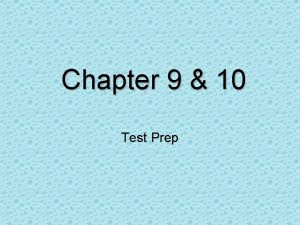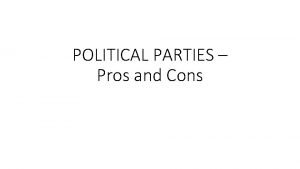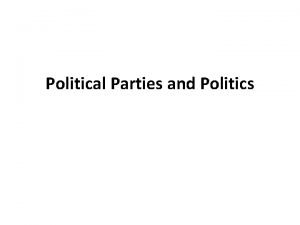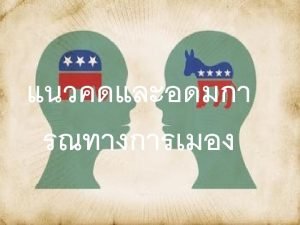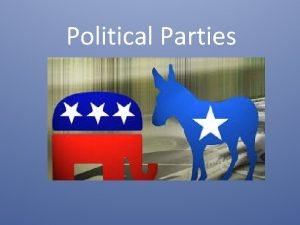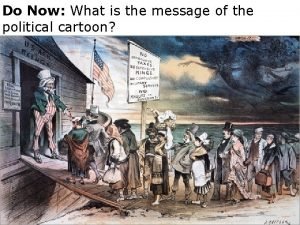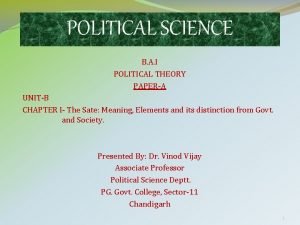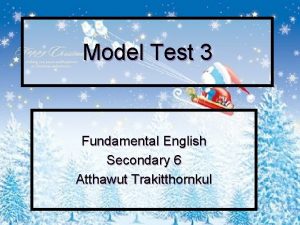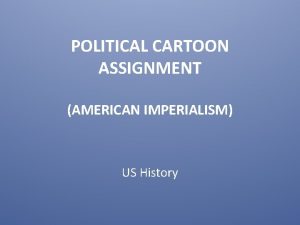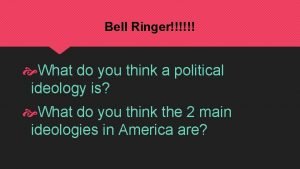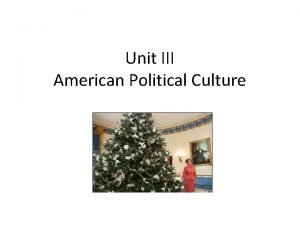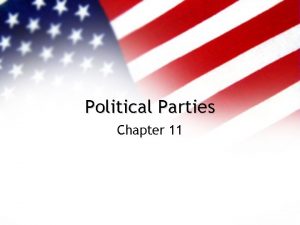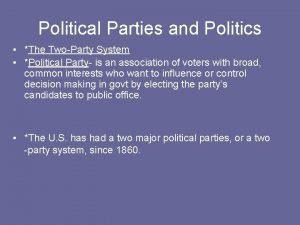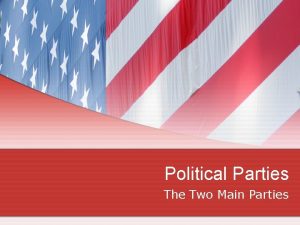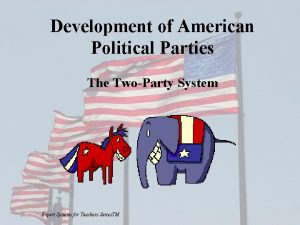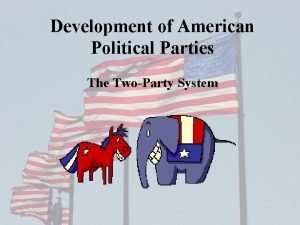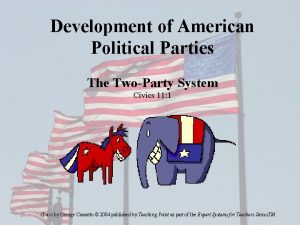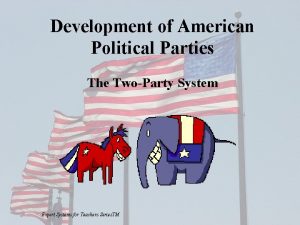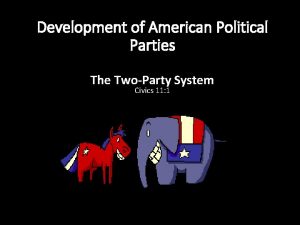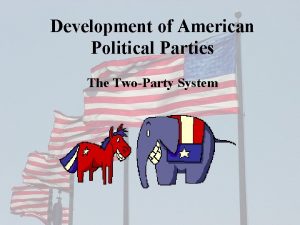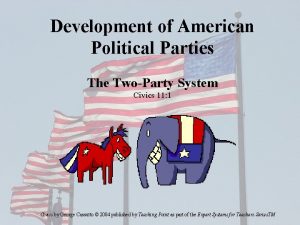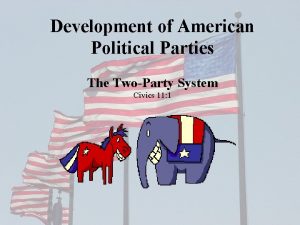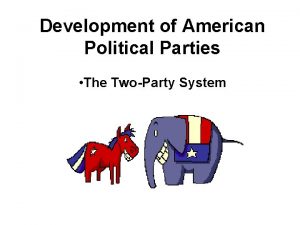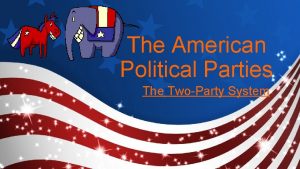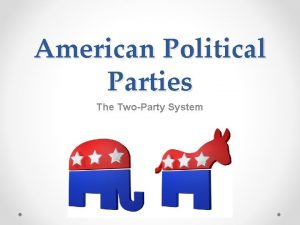American Political Parties Our TwoParty System History and



















- Slides: 19

American Political Parties Our Two-Party System History and Functions

Today’s Objectives � Identify the purpose of Political Parties � Explain the origins of the 2 -Party System in the US � Explain the organization of political parties � Identify the various types of 3 rd Parties � Explain realignment/dealig nment

Parties in the US � Definition ◦ Group that seeks to elect candidates to public office by supplying them with a label by which they are known to the electorate. (AKA Party Identification) � Parties are present in 3 Arenas ◦ Label ◦ Organization(recruit, campaign) ◦ Leadership/Control of Government ◦ *** Parties have lost power in all three arenas

Decentralization of Party Power � Federalism decentralizes power. . how? � National parties used to be a coalition of local parties. � Now Parties organize at all levels � ****All politics are local**** � Candidates are chosen through primaries not by party leaders

Rise and Fall of Parties � Disliked by Washington/ � Needed by others to distinguish between policy disputes and challenges to a legitimate gov’t � EX Jefferson and Alien Sedition Acts � Jefferson vs. Hamilton/Adams � Caucuses of political nobles � Philosophical clubs/not mass associations � Early domination by Democratic/Republi cans

History of Parties � Parties were formed as coalitions for victory not homogeneous groups. Today? � 1820’s mass participation begins � 1832 – presidential electors are chosen by popular vote in most states � 1836 Democrats Hold first National Convention to Nominate their Presidential Candidate. � Civil War to Great Depression � Politics based on Sectionalism � Factions emerge (Progressives)

Progessive Era Reforms � Progressives worked to curb the power of political machines � Favored primaries � Voter registration requirements become strict � Civil Service Exam � Intro of referendums/initiativ es. � 17 th Amendment � Effects ◦ Eliminated the worst forms of political corruption ◦ Weakened Parties ◦ How? ◦ Office Holders Accountable to people not parties as much

Party Structure � Both parties are similar on paper � National Convention and Formal Power ◦ Meets every 4 years to nominate presidential candidates ◦ Composed of Delegates from states � Congressional Campaign Committees support the party’s candidates � National Party Chair manages day to day work of the Party � www. dnc. org � www. gop. org

Party Structure � RNC � More bureaucratic � Discipline � Well-financed party � Especially in Congressional Elections � Computer Fundraising / Data Bases � DNC � Factionalized � Redistribution of power � Mc. Govern Reforms ◦ Women ◦ Youth ◦ Minorities

National Conventions � National committee sets the time and place � # of delegates per states (GOP loyalty, Dems size) � GOP gives more delegate to the South and Southwest � Democrats give more delegates to the West and Northeast. � The Party in Power (executive branch) goes last. � Post Convention bump

Third Parties Any party other than the two major parties can be called a “Third party. ” � No third party has ever gained control of the White House. Sometimes, third parties win seats in Congress or gain office in lower levels of government. � When these smaller groups challenge the two major parties, they can change the outcome of elections. � Their most important role is to influence policy on one or more issues. � Ralph Nader, Green Party Candidate, 2000

Ideological Third Parties � An ideology is a body of ideas put forth by a person or group. � Minor third parties are often formed to support a specific issue. These rise and fall over time. � Ideological parties want to change society in major ways. � The Socialist and Communist Parties want to nationalize major industries. The Green Party calls for companies to respect the environment.

Cult of Personality � Some third parties form from the efforts of famous people. � If they cannot gain support from one of the major parties, they form their own. � H. Ross Perot’s Reform Party was a force in the 1992 and 1996 elections. This party also placed pro wrestler Jesse Ventura in the governor’s mansion in Minnesota. � These parties usually fade after their candidate is defeated.

The Odds Are Against Them � It is difficult for third parties candidates to raise enough money to compete with the major parties. � Only one candidate can win in a given district. Usually the winner is either Democratic or Republican. � Third-party candidates must show they have support by getting voter signatures to even be placed on the ballot for national office.

Parties Move Towards The Center A platform is a statement that puts forth the party's positions on issues. Each individual issue is called a plank. � Both parties want votes. As a result, parties become more moderate in their platforms, moving away from extreme positions. � The American people generally agree about many issues. This unity forces the two parties toward the center of the political spectrum. �

Types of Parties or Political Followings � Ideological � Solidary groups � Sponsored Parties � Personal Following -name recognition ◦ Kennedys/Bushs

2 -Party System � Rare today � Why in America? � 1) Electoral System/winner take all and plurality system � 2) Moderate opinions � 3) Election Laws

Realignment � What is it? � When major shifts in the population SWITCH parties � Examples? � Jackson Era � Civil War (Sectionalism) � New Deal � Post Civil Rights Era

Dealignment � What � Why? is it? � Voters are moving away from both parties/call themselves Independent � Benefits of party membership?
 What was one way progressives differed from populists
What was one way progressives differed from populists Political parties pros and cons
Political parties pros and cons Brainpop presidential election
Brainpop presidential election Political parties
Political parties Political parties
Political parties Political
Political Sistemas democraticos
Sistemas democraticos Political parties
Political parties Accounting information system chapter 1
Accounting information system chapter 1 Awareness of ourselves and our environment is:
Awareness of ourselves and our environment is: Awareness of ourselves and our environment is
Awareness of ourselves and our environment is Awareness of ourselves and our environment is
Awareness of ourselves and our environment is Awareness of ourselves and our environment is:
Awareness of ourselves and our environment is: The proposed emigrant dumping site cartoon meaning
The proposed emigrant dumping site cartoon meaning Relation of political science with psychology
Relation of political science with psychology If a ruby is heated it temporarily lose its color
If a ruby is heated it temporarily lose its color American imperialism political cartoons explained
American imperialism political cartoons explained What does this image depict?
What does this image depict? American political spectrum
American political spectrum American political culture definition
American political culture definition
